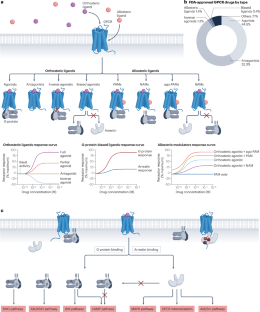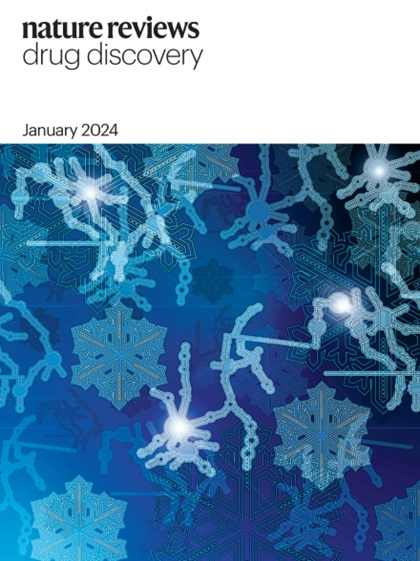Functional dynamics of G protein-coupled receptors reveal new routes for drug discovery
IF 122.7
1区 医学
Q1 BIOTECHNOLOGY & APPLIED MICROBIOLOGY
引用次数: 0
Abstract
G protein-coupled receptors (GPCRs) are the largest human membrane protein family that transduce extracellular signals into cellular responses. They are major pharmacological targets, with approximately 26% of marketed drugs targeting GPCRs, primarily at their orthosteric binding site. Despite their prominence, predicting the pharmacological effects of novel GPCR-targeting drugs remains challenging due to the complex functional dynamics of these receptors. Recent advances in X-ray crystallography, cryo-electron microscopy, spectroscopic techniques and molecular simulations have enhanced our understanding of receptor conformational dynamics and ligand interactions with GPCRs. These developments have revealed novel ligand-binding modes, mechanisms of action and druggable pockets. In this Review, we highlight such aspects for recently discovered small-molecule drugs and drug candidates targeting GPCRs, focusing on three categories: allosteric modulators, biased ligands, and bivalent and bitopic compounds. Although studies so far have largely been retrospective, integrating structural data on ligand-induced receptor functional dynamics into the drug discovery pipeline has the potential to guide the identification of drug candidates with specific abilities to modulate GPCR interactions with intracellular effector proteins such as G proteins and β-arrestins, enabling more tailored selectivity and efficacy profiles. Recent advances in structural biology techniques and computational simulations have enhanced our understanding of the conformational dynamics of G protein-coupled receptors and their interactions with ligands. This Review highlights how such advances may be used in the discovery and optimization of drugs that target G protein-coupled receptors, focusing on three categories: allosteric modulators, biased ligands, and bivalent and bitopic compounds.


G蛋白偶联受体的功能动力学揭示了药物发现的新途径
G蛋白偶联受体(gpcr)是最大的人膜蛋白家族,可将细胞外信号转化为细胞反应。它们是主要的药理学靶点,大约26%的上市药物靶向gpcr,主要靶向它们的正位结合位点。尽管它们很突出,但由于这些受体复杂的功能动力学,预测新型gpcr靶向药物的药理作用仍然具有挑战性。x射线晶体学、低温电子显微镜、光谱技术和分子模拟的最新进展增强了我们对受体构象动力学和配体与gpcr相互作用的理解。这些进展揭示了新的配体结合模式、作用机制和药物口袋。在这篇综述中,我们重点介绍了最近发现的靶向gpcr的小分子药物和候选药物的这些方面,重点介绍了三类:变构调节剂、偏置配体、二价和双价化合物。尽管到目前为止的研究主要是回顾性的,但将配体诱导受体功能动力学的结构数据整合到药物发现管道中,有可能指导鉴定具有特定能力的候选药物,以调节GPCR与细胞内效应蛋白(如G蛋白和β-阻滞蛋白)的相互作用,从而实现更定制的选择性和功效谱。
本文章由计算机程序翻译,如有差异,请以英文原文为准。
求助全文
约1分钟内获得全文
求助全文
来源期刊

Nature Reviews. Drug Discovery
医学-生物工程与应用微生物
CiteScore
137.40
自引率
0.30%
发文量
227
期刊介绍:
Nature Reviews Drug Discovery is a monthly journal aimed at everyone working in the drug discovery and development arena.
Each issue includes:
Highest-quality reviews and perspectives covering a broad scope.
News stories investigating the hottest topics in drug discovery.
Timely summaries of key primary research papers.
Concise updates on the latest advances in areas such as new drug approvals, patent law, and emerging industry trends and strategies.
 求助内容:
求助内容: 应助结果提醒方式:
应助结果提醒方式:


